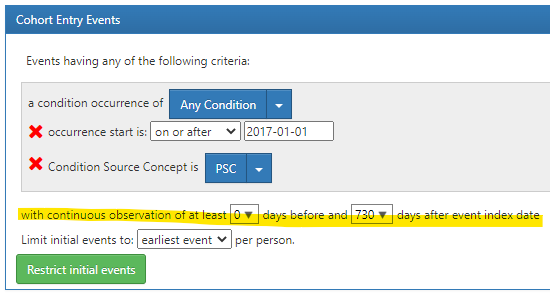Hello, it might be a simple question… but I’m just curious about the difference between ‘continuous observation’ and ‘observation period’ when I’m designing cohort in cohort definition tab.
It would be great if anyone can answer my question! Thanks ![]()
| OHDSI Home | Forums | Wiki | Github |
Hello, it might be a simple question… but I’m just curious about the difference between ‘continuous observation’ and ‘observation period’ when I’m designing cohort in cohort definition tab.
It would be great if anyone can answer my question! Thanks ![]()
@yeorim Sorry but I cannot understand what you mean exactly. If you’re Korean, could you replicate it in Korean and describe the details?
Luckily, I’m in the vicinity of @yeorim, so after meeting her in the real world, I explained the above problem.
Thanks for explaining to me face-to-face!! 
For anyone who is also faced with this question, I will try to explain the concepts/difference:
Observation Periods indicate the period of time (indicated with a start and end date) where it is possible for a person to have observed events. In Health Claims context, this would be enrollment because a health plan won’t have records of care if you haven’t been enrolled with the plan (how would they know you exist?).
Continuous observation means that between 2 points in time, there is no gap in the observation period, or the two points in time is completely contained inside a single observation period.
When searching for cohort entry events in cohort definition, you have the option to specify ‘prior continuous observation’ and ‘post continuous observation’, which means: at the time of the entry event, is there continuous observation between X days before the entry event start date (prior) or Y days after the entry event start date (post). So, Observation period have a set calendar start-end, and continuous observation is determned by taking the entry event start date, and making another calendar period based on start - prior days and start. If start-prior to start falls within the observation period, then the prior days is ‘continuous’.
Why do you want to enforce ‘continuous’? For cases where you want to say something like ‘there is no observation of N in the prior 180 days’, you should require that there is actually 180 days of prior continuous observation. If you don’t, then you will determine that a person with 0 days of prior observation didn’t have an exclusion event, but if they don’t have the actual prior observation, you can’t actually make that determination.
Other cases is looking for people with a minimum amount of follow up: if you require ‘post continuous observation’, then that means that the person is still within an observation period for at least the number of post-observation days. This is helpful when you want to do a study and you need to observe the person in data for at least 180 days: you set the post-continuous observation to 180.
Hi all, resurfacing this discussion as I have a relevant question that’s baffling me all afternoon ![]()
Please refer to the following cohort definitions. Cohort exit criteria for both cohorts are set to end of continuous observation.

As the only difference between the two cohorts is how I chose to add the post-continuous observation criteria (highlighted in yellow), I expected both cohorts to have the exact same number of people but the first cohort is revealing 6 more people than the second cohort. All of the people in the second cohort are included in the first cohort with exactly the same cohort_start_dates and cohort_end_dates.
I have no idea why the second cohort is filtering out the 6 people of the first cohort even though they all seem to satisfy post-continuous observation of at least 730 days (as shown below). Any ideas anyone ![]() ?
?
| subject_id | cohort_start_date | cohort_end_date | DATEDIFF >= 730 |
|---|---|---|---|
| 1 | 2019-05-09 | 2021-09-30 | Y |
| 2 | 2019-03-25 | 2021-09-30 | Y |
| 3 | 2019-04-30 | 2021-09-30 | Y |
| 4 | 2019-04-22 | 2021-06-30 | Y |
| 5 | 2019-07-17 | 2021-09-30 | Y |
| 6 | 2019-05-12 | 2021-09-30 | Y |
The UI provides the SQL so that you can run through the queries yourself to see where people are selected as cohort entry, and then when they are dropped from cohort inclusion. So, one thing to try is executing the sql to see what happens. This usually reveals the logical inconsistency.
However, I think I know what’s happening in your case:
Your first cohort is ensuring that the earliest event per person has the required post-observation. This could involve evaluating multiple events before finding the one that has the required post-observation, and then you are selecting the ‘earliest’.
The second cohort is just picking an earliest event without considering observation, and then (with that earliest event), it’s checking the post-observation.
What if you have a person with 2 observation periods, and in the earlier one, you have PSC but not 765 post-observation, but in the later observation period, you have a PSC that does have 765 post observation. The first cohort expression will find the second PSC event, while the second one will first select the first PSC event, and then check to see if it has 765 post observation (which it won’t). That will cause the person to be dropped.
To confirm, change your second one to use all-events per person, but then after your inclusion criteria, select ‘earliest event per person’. Then things should match up.
Hi Chris, you just made my day 
Your assumption was indeed correct and changing the cohort entry event to all events did the trick 
Thanks bunch for your extremely straightforward explanation!